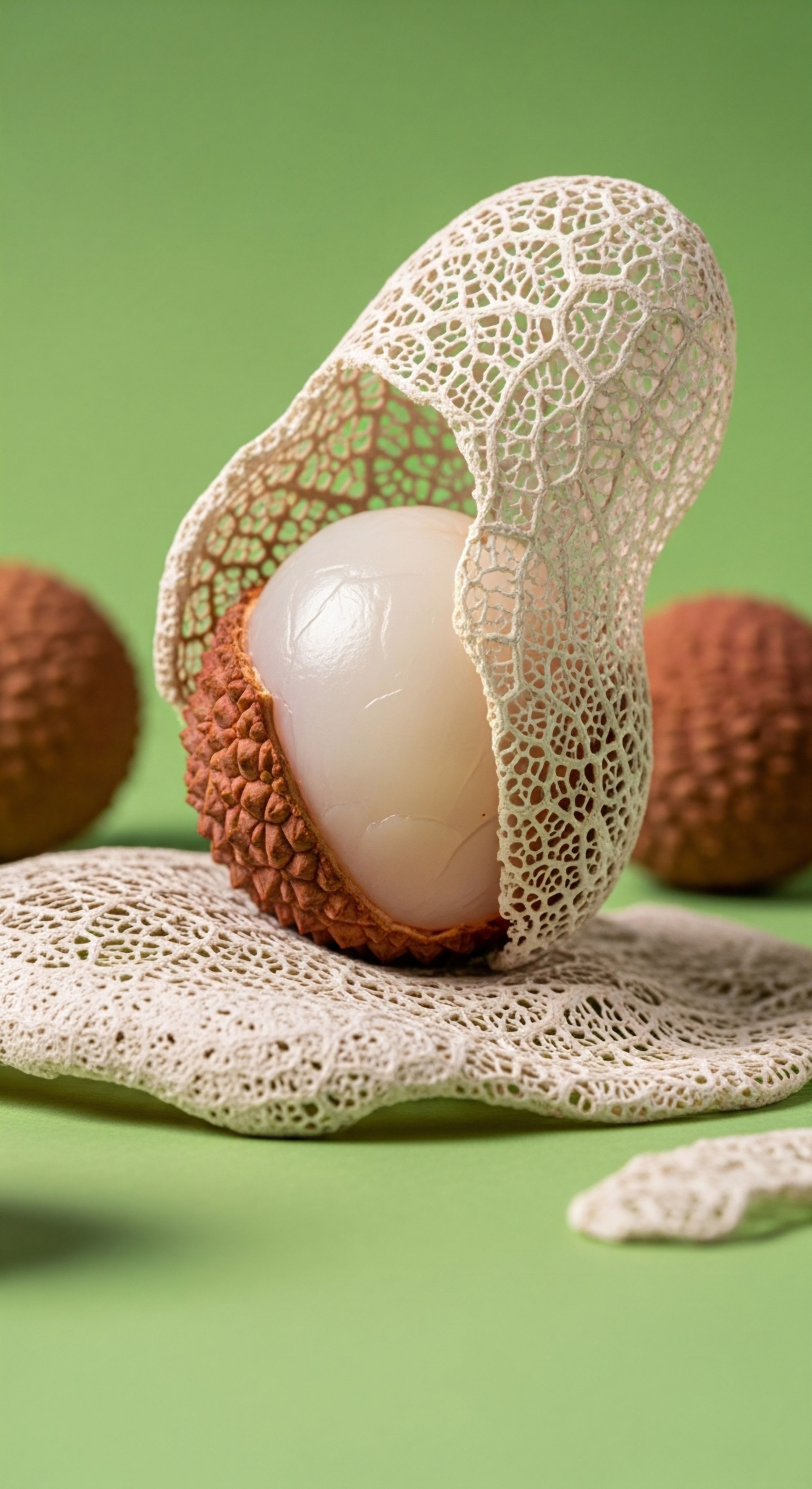

Fundamentals
You look in the mirror and notice a change. It’s a subtle shift in the texture of your skin, a loss of the familiar plumpness around your jawline, or a dryness that no amount of moisturizer seems to satisfy. This experience, this quiet observation, is a valid and deeply personal starting point. It is the beginning of a conversation between you and your body.
The changes you see on the surface are direct reflections of a profound internal recalibration, a shift in the intricate communication network of your endocrine system. Understanding this connection is the first step toward addressing the root cause of these changes, moving from a sense of passive observation to one of active, informed partnership with your own biology.
The beauty of your skin, its resilience and vitality, is fundamentally tied to the presence and balance of specific hormones. These biochemical messengers orchestrate a constant symphony of cellular activity, and when their levels change, the skin is one of the first and most visible organs to register the difference. This process is not a failure of your body; it is a predictable biological transition. By learning the language of your hormones, you can begin to comprehend the story your skin is telling and learn how to support its health from a foundational level.

The Architects of Your Skin’s Structure
Three primary hormones act as the chief architects of your skin’s integrity and appearance ∞ estrogen, progesterone, and testosterone. Each has a distinct and cooperative role, and their collective balance is what creates the smooth, hydrated, and firm qualities associated with healthy skin. When we talk about hormonal aging, we are really talking about the diminishing influence of these key regulators.

Estrogen the Master Builder
Estrogen, particularly estradiol (E2), is the principal hormone responsible for the skin’s structural integrity and youthful appearance. Its influence is comprehensive and profound. Estrogen directly stimulates specialized cells in the dermis called fibroblasts. These fibroblasts are the factories that produce collagen, the most abundant protein in your skin, which provides its strength and framework.
Think of collagen as the scaffolding that holds everything up; robust collagen production Meaning ∞ Collagen production refers to the biological process by which fibroblasts and other specialized cells synthesize collagen, the most abundant protein in the human body, forming strong, structural fibers that provide integrity and elasticity to connective tissues. keeps the skin firm and resists sagging. Studies have shown that estrogen supports the synthesis of both Type I and Type III collagen, which are critical for skin structure.
Beyond collagen, estrogen is instrumental in maintaining skin hydration. It promotes the production of hyaluronic acid, a molecule that can hold up to 1,000 times its weight in water. This natural humectant draws moisture into the skin, giving it a plump, dewy quality. Estrogen also supports the skin’s barrier function, helping to lock in moisture and protect against environmental stressors.
As estrogen levels Meaning ∞ Estrogen levels denote the measured concentrations of steroid hormones, predominantly estradiol (E2), estrone (E1), and estriol (E3), circulating within an individual’s bloodstream. decline, particularly during perimenopause and menopause, women may lose up to 30% of their skin’s collagen within the first five years. This loss directly translates to thinner, drier skin and the formation of fine lines and wrinkles.

Progesterone the Harmonizing Agent
Progesterone works in concert with estrogen, acting as a balancing and refining influence on the skin. While estrogen is the primary builder, progesterone contributes to skin elasticity Meaning ∞ Skin elasticity refers to the dermis’s capacity to return to its original form following stretching, pinching, or deformation. and may help to inhibit the overactivity of certain enzymes that break down collagen. Its most noticeable effect is on sebum production. Sebum is the natural oil produced by the skin’s sebaceous glands, and it is a vital component of the skin’s protective barrier.
Progesterone can increase sebum production, which helps to keep the skin lubricated and contributes to the healthy “glow” often associated with certain phases of the menstrual cycle or pregnancy. When progesterone levels fall along with estrogen, the skin can become drier and lose some of its suppleness. A balanced hormonal protocol recognizes the importance of progesterone in creating a holistic effect on skin texture and appearance.

Testosterone the Regulator of Thickness and Strength
Though often considered a male hormone, testosterone is present and vital for both sexes. In the context of skin health, testosterone plays a significant role in maintaining the thickness and resilience of the dermis. It supports the structural integrity of the skin and contributes to the overall robustness of the tissue.
For women, a small amount of testosterone is essential for this structural support. In men, healthy testosterone levels are directly linked to thicker, more resilient skin throughout life.
Testosterone is also a primary driver of sebum production. During puberty, a surge in testosterone is what kicks the sebaceous glands into high gear, which is why acne is so common in adolescence. In adulthood, balanced testosterone levels contribute to healthy skin lubrication.
When testosterone levels are imbalanced, either too high or fluctuating wildly in relation to other hormones, it can lead to excessive sebum production, clogged pores, and inflammatory acne, particularly along the jawline, chest, and back. This is a key consideration in hormonal optimization Meaning ∞ Hormonal Optimization is a clinical strategy for achieving physiological balance and optimal function within an individual’s endocrine system, extending beyond mere reference range normalcy. protocols, where maintaining the correct balance is paramount.
The visible changes in skin texture and firmness are a direct reflection of declining levels of key hormones that govern collagen production and hydration.

The Inevitable Decline and the Opportunity for Intervention
The process of hormonal decline is a natural part of the human lifecycle. For women, perimenopause and menopause mark a steep drop in estrogen and progesterone production by the ovaries. For men, andropause involves a more gradual decline in testosterone.
This reduction in hormonal signaling directly impacts the skin’s ability to repair itself, to produce collagen, and to retain moisture. The result is a predictable cascade of changes ∞ the skin becomes thinner, drier, less elastic, and more prone to wrinkling.
This understanding of the biological mechanisms at play is incredibly empowering. The changes you observe are not simply cosmetic issues to be addressed with topical creams alone. They are systemic signals from your body. Hormone replacement Meaning ∞ Hormone Replacement involves the exogenous administration of specific hormones to individuals whose endogenous production is insufficient or absent, aiming to restore physiological levels and alleviate symptoms associated with hormonal deficiency. therapy, or more accurately, hormonal optimization, is a clinical strategy designed to address these changes at their source.
By restoring key hormones to optimal physiological levels, these protocols can directly counteract the cellular processes of skin aging. They work from the inside out, instructing the fibroblasts to resume robust collagen production and supporting the skin’s natural ability to hydrate and protect itself. This is the foundation of reclaiming your skin’s vitality, viewing hormonal health as the central pillar of its beauty and function.


Intermediate
Understanding that hormonal decline impacts skin is the first layer of knowledge. The next is to comprehend the precise biological conversations that are being silenced and how a well-designed hormonal protocol can restart them. The skin is an endocrine organ, covered in millions of tiny receivers waiting for messages from the body’s master regulators.
When these messages cease, the skin’s cellular machinery slows down. Hormonal optimization is a process of restoring that essential communication, speaking directly to the cells in a language they are designed to understand.
The effectiveness of any hormonal protocol lies in its specificity. It is a targeted intervention that reintroduces the exact biochemical signals that have been lost. This is achieved by using bioidentical hormones, molecules that are structurally identical to those your body naturally produces.
This molecular mimicry allows them to bind perfectly to the hormone receptors on your skin cells, initiating the same downstream effects as the hormones your body produced in its prime. The goal is to re-establish the physiological environment that fosters cellular health and vitality, thereby improving skin quality from the dermal layer outward.

The Cellular Dialogue Receptors and Responses
The surface of skin cells, particularly the fibroblasts and keratinocytes, are dotted with specialized proteins called hormone receptors. Think of these receptors as docking stations, each shaped to fit a specific hormone molecule. When a hormone like estrogen circulates through the bloodstream and reaches the skin, it binds to its corresponding estrogen receptor (ER), specifically the ERβ receptor which is abundant in the skin. This binding event is like a key turning in a lock; it triggers a cascade of events inside the cell.
The activated receptor sends a signal directly to the cell’s nucleus, the command center that houses its DNA. This signal instructs the cell to turn on specific genes, namely the genes responsible for producing Type I and Type III collagen and hyaluronic acid.
This is a direct, mechanistic link. The presence of estrogen actively tells the skin to build its own structural proteins and hydrating molecules. When estrogen levels fall, these docking stations sit empty. The signal is lost, and the cellular factories for collagen and hyaluronic acid Meaning ∞ Hyaluronic Acid is a naturally occurring anionic glycosaminoglycan, a polysaccharide widely distributed throughout connective, epithelial, and neural tissues. go quiet.
A protocol that reintroduces estradiol provides the necessary keys to turn these factories back on, leading to measurable increases in skin thickness, collagen density, and moisture retention. The same principle applies to testosterone and progesterone, which bind to their own specific receptors to regulate sebum production Meaning ∞ Sebum production refers to the physiological process by which sebaceous glands synthesize and secrete sebum, an oily, waxy substance, onto the skin and hair follicles. and skin thickness.

How Do Clinical Protocols Address Skin Health?
A sophisticated approach to hormonal health recognizes that it is a symphony, not a solo. The various hormones must be in the correct ratio to one another for optimal effect. Clinical protocols Meaning ∞ Clinical protocols are systematic guidelines or standardized procedures guiding healthcare professionals to deliver consistent, evidence-based patient care for specific conditions. are designed to restore this balance, considering the unique needs of both men and women.
- For Women ∞ A typical protocol for a perimenopausal or postmenopausal woman involves replacing both estrogen and progesterone. Estradiol, delivered via injections, patches, or creams, is the primary agent for stimulating collagen and restoring hydration. Progesterone is co-administered, often in oral or topical form, to provide balance. It helps to modulate the effects of estrogen and contributes to skin elasticity and healthy oil production. In many cases, a low dose of testosterone is also included. Weekly subcutaneous injections of Testosterone Cypionate (typically 0.1-0.2ml) can significantly improve skin thickness and resilience, contributing to a more robust and healthy skin barrier.
- For Men ∞ The standard protocol for men with low testosterone involves weekly intramuscular injections of Testosterone Cypionate (e.g. 200mg/ml). This directly addresses the loss of skin thickness and resilience associated with andropause. A critical component of this protocol is the management of estrogen. Testosterone can be converted into estrogen in the body by an enzyme called aromatase. To prevent an unhealthy rise in estrogen levels, which can have its own side effects, an aromatase inhibitor like Anastrozole is often prescribed. This ensures that the hormonal ratio remains optimized, maximizing the benefits of testosterone while controlling potential downsides. Additionally, medications like Gonadorelin are used to maintain the body’s own hormonal signaling pathways, supporting a more integrated and sustainable physiological balance.

Comparing the Hormonal Impact on Skin Parameters
The distinct roles of each hormone become clearer when we examine their specific contributions to the measurable qualities of the skin. A well-balanced hormonal environment leverages the unique strengths of each hormone to create a comprehensive improvement in skin health.
| Skin Component | Estrogen’s Role | Progesterone’s Role | Testosterone’s Role |
|---|---|---|---|
| Collagen Production |
Directly stimulates fibroblasts to produce Type I and III collagen, increasing skin firmness and density. |
May offer a supportive role by modulating collagen breakdown, contributing to overall structural integrity. |
Maintains dermal thickness and supports the collagen matrix, contributing to skin’s structural robustness. |
| Elasticity |
Improves skin elasticity by supporting the production of elastin fibers alongside collagen. |
Significantly increases the elastic properties of the skin, helping it to retain its shape and firmness. |
Contributes to skin’s resilience and ability to withstand stretching without damage. |
| Hydration |
Strongly promotes the synthesis of hyaluronic acid, the skin’s primary natural moisturizing factor. |
Contributes to skin hydration, though its primary mechanism is through influencing oil production and blood flow. |
Does not directly influence hydration but supports a healthy skin barrier through sebum production. |
| Sebum (Oil) Production |
Generally suppresses sebum production, which can lead to dryness when estrogen is unopposed. |
Increases sebum production, which helps to lubricate the skin and contributes to a healthy “glow.” |
Is the primary driver of sebum production; balanced levels are key for healthy lubrication without causing acne. |
| Skin Thickness |
Increases the thickness of both the epidermis and the dermis by stimulating cellular proliferation and collagen synthesis. |
Contributes to skin firmness, which is a component of overall thickness and density. |
Directly supports the maintenance of dermal thickness, preventing the thinning associated with hormonal decline. |
Restoring hormonal balance with bioidentical hormones re-establishes direct communication with skin cells, reactivating their innate ability to produce collagen and retain moisture.
This targeted approach underscores a fundamental principle of personalized wellness. The goal is not simply to add hormones, but to recalibrate a complex system. By understanding the specific roles of estrogen, progesterone, and testosterone, and by administering them in a way that respects their synergistic relationship, clinical protocols can effectively reverse many of the visible signs of aging in the skin. This process is a functional restoration, giving the skin back the tools it needs to maintain its own health, structure, and beauty.
Academic
A sophisticated analysis of hormonal influence on cutaneous biology requires moving beyond the organ level to a systems-based perspective. The skin’s aging process is a peripheral manifestation of central regulatory changes, primarily governed by the Hypothalamic-Pituitary-Gonadal (HPG) axis. This neuroendocrine cascade dictates the pulsatile release and systemic levels of gonadotropins and steroid hormones, which in turn modulate the cellular machinery of the dermis and epidermis. Therefore, the application of hormonal therapies is an intervention within this complex feedback system, aiming to restore a physiological signaling environment that has been attenuated by age.
The molecular mechanisms underpinning these effects are intricate, involving genomic and non-genomic signaling pathways, the regulation of protein synthesis, and the modulation of enzymatic activity. A deep dive into the scientific literature reveals that estrogen’s role, in particular, is central to maintaining the skin’s youthful biomechanical properties. Its decline during menopause initiates a cascade of degradative processes that outpace the skin’s synthetic and repair capabilities. Understanding these pathways is critical to appreciating the profound efficacy of hormonal optimization protocols.

Molecular Endocrinology of Cutaneous Aging
The primary mechanism through which estrogen exerts its profound effects on the skin is via its interaction with specific nuclear hormone receptors, predominantly Estrogen Receptor β (ERβ), which is highly expressed in dermal fibroblasts and keratinocytes. Upon binding estradiol, the ERβ dimerizes and functions as a ligand-activated transcription factor. It binds to specific DNA sequences known as Estrogen Response Elements (EREs) in the promoter regions of target genes.
This action directly upregulates the transcription of genes coding for COL1A1 and COL3A1, the primary chains for Type I and Type III collagen, respectively. This genomic pathway is the fundamental basis for estrogen’s role in maintaining the skin’s tensile strength and structural framework.
Simultaneously, estrogen exerts a crucial regulatory influence on the enzymes responsible for collagen degradation. Matrix Metalloproteinases Meaning ∞ Matrix Metalloproteinases, commonly abbreviated as MMPs, are a family of zinc-dependent enzymes responsible for the controlled breakdown of components within the extracellular matrix, including various collagens, elastin, and fibronectin, facilitating tissue turnover and structural adaptation. (MMPs), a family of zinc-dependent endopeptidases, are the primary agents of extracellular matrix breakdown. MMP-1 (collagenase) and MMP-9 (gelatinase) activity increases with age and in states of estrogen deficiency. Clinical data demonstrate that estrogen administration downregulates the expression of these MMPs.
This dual action—simultaneously increasing collagen synthesis Meaning ∞ Collagen synthesis is the precise biological process by which the body constructs collagen proteins, its most abundant structural components. while decreasing its degradation—creates a powerful net anabolic effect on the dermal matrix. This is a key reason why the skin of postmenopausal women on hormone therapy retains its thickness and resilience far better than that of their non-treated counterparts.

Evidence from Clinical Intervention Trials
The theoretical benefits of hormonal therapy on skin are substantiated by a robust body of clinical evidence from prospective, randomized controlled trials. These studies provide quantitative data on the structural and functional improvements in the skin following the administration of hormone therapy. A systematic review and meta-analysis of such trials confirmed that Menopausal Hormone Therapy (MHT) produces statistically significant increases in skin elasticity, skin thickness, and collagen content.
One notable study highlighted in the literature demonstrated that women receiving oral estrogen therapy showed a significant increase in skin thickness and collagen levels compared to a placebo group. Another trial found that even topical application of estrogen could increase procollagen levels, indicating a direct local effect on the skin’s synthetic machinery. These studies collectively affirm that restoring physiological estrogen levels directly combats the atrophic changes seen in menopausal skin.
| Study Focus & Design | Intervention | Duration | Key Findings on Skin Parameters |
|---|---|---|---|
| Skin Elasticity (RCT) |
Oral 17β-estradiol/dydrogesterone |
7 months |
Statistically significant increase in skin elasticity at the ramus of the mandible compared to baseline. |
| Dermal Thickness (RCT) |
Oral conjugated equine estrogens |
6 months |
Reported a 33% increase in dermal thickness in the treatment group compared to placebo. |
| Collagen Content (Meta-Analysis) |
Various oral/transdermal MHT |
Variable |
Showed a standardized mean difference of 2.01, indicating a very large and significant increase in collagen content with MHT. |
| Skin Hydration (Cohort Study) |
Estrogen therapy |
N/A |
Women not receiving HRT were significantly more likely to report issues with skin dryness. |

The Role of Growth Hormone Peptides in Skin Rejuvenation
While sex steroids are the direct architects of the skin’s matrix, the Growth Hormone (GH) / Insulin-like Growth Factor-1 (IGF-1) axis provides critical systemic support for cellular repair and regeneration. In aging individuals, the decline in GH secretion (somatopause) parallels the decline in sex hormones. Peptide therapies, such as Sermorelin Meaning ∞ Sermorelin is a synthetic peptide, an analog of naturally occurring Growth Hormone-Releasing Hormone (GHRH). and Ipamorelin/CJC-1295, are designed to stimulate the pituitary gland to produce and release more of the body’s own GH. This elevation in GH and subsequently IGF-1 has beneficial effects on the skin.
IGF-1 promotes keratinocyte proliferation, enhances wound healing, and supports the function of dermal fibroblasts. This creates a synergistic effect with sex hormone optimization. While estrogen and testosterone directly command the fibroblasts to produce collagen, GH and IGF-1 ensure that these cells are healthy, robust, and capable of carrying out those commands efficiently. This integrated approach, addressing both the HPG and the GH/IGF-1 axes, represents a more comprehensive strategy for combating the systemic processes of aging as they are reflected in the skin.
Scientific evidence confirms that hormonal therapy mechanistically counteracts skin aging by upregulating collagen gene expression and downregulating the enzymes responsible for its degradation.
What are the procedural implications for administering these therapies in China? The regulatory landscape for hormone and peptide therapies can vary significantly by jurisdiction. In China, the National Medical Products Administration (NMPA) governs the approval and use of such treatments. Any clinic offering these protocols would need to ensure strict compliance with NMPA guidelines, including the use of approved pharmaceutical agents and adherence to established clinical protocols.
The importation and prescription of specific peptides or bioidentical hormone formulations would be subject to these regulations, potentially requiring specific licensing or approvals that differ from those in North America or Europe. This legal framework is a critical consideration for the clinical application of these advanced wellness strategies.
References
- Lephart, Edwin D. “Skin aging and oxidative stress ∞ Estrogen’s role in cellular protection.” International Journal of Molecular Sciences, vol. 24, no. 2, 2023, p. 1234.
- Rzepecki, A.K. et al. “Estrogen-deficient skin ∞ The role of topical therapy.” International Journal of Women’s Dermatology, vol. 5, no. 2, 2019, pp. 85-90.
- Wilkinson, H.N. and M.J. Hardman. “The role of estrogen in cutaneous ageing and repair.” Maturitas, vol. 103, 2017, pp. 60-64.
- Stevenson, S. and J. Thornton. “Effect of estrogens on skin aging and the potential role of SERMs.” Clinical Interventions in Aging, vol. 2, no. 3, 2007, pp. 283-297.
- Kim, H.J. et al. “Skin Rejuvenation in Women using Menopausal Hormone Therapy ∞ A Systematic Review and Meta-Analysis.” Journal of Menopausal Medicine, vol. 27, no. 1, 2021, pp. 1-12.
- Holzer, G. et al. “A prospective, randomized, double-blind, placebo-controlled study on the influence of a hormone replacement therapy on skin aging in postmenopausal women.” Climacteric, vol. 11, no. 5, 2008, pp. 397-404.
- Piérard-Franchimont, C. et al. “Hormone replacement therapy for menopause and skin viscoelasticity.” Maturitas, vol. 32, no. 1, 1999, pp. 49-54.
- Zipper, S.C. and M.A. Zipper. “The role of progesterone in skin health ∞ a review.” Journal of Clinical & Experimental Dermatology Research, vol. 11, no. 5, 2020, p. 525.
- Ganceviciene, R. et al. “Skin anti-aging strategies.” Dermato-Endocrinology, vol. 4, no. 3, 2012, pp. 308-319.
- Zouboulis, C.C. et al. “Sexual hormones in human skin.” Hormone and Metabolic Research, vol. 39, no. 2, 2007, pp. 85-95.
Reflection
The information presented here offers a map of the biological territory, connecting the visible world of your skin to the invisible, intricate network of your endocrine system. This knowledge is a powerful tool, shifting the perspective from one of passively witnessing change to one of understanding the underlying mechanisms. It provides a framework for comprehending why your skin is changing and illuminates a clear, evidence-based path for intervention and support. This map, however, is not the journey itself.
Your personal health story is unique, written in the language of your own genetics, lifestyle, and experiences. The symptoms you feel and the changes you see are your body’s specific dialect. The true potential of this clinical science is realized when it is applied with precision to your individual biology. Consider the information you have absorbed as the beginning of a new, more informed dialogue with your body.
What questions has it raised for you about your own experiences? How does this systemic view of health resonate with the changes you have observed over time?
The path toward sustained vitality is one of proactive partnership. It involves listening to the signals your body sends and seeking guidance to interpret them accurately. The ultimate goal is to move through life not as a passenger, but as a knowledgeable and empowered pilot of your own biological systems. This journey of biochemical recalibration is about restoring function, reclaiming vitality, and ensuring that your internal health is fully and beautifully reflected on the outside.












